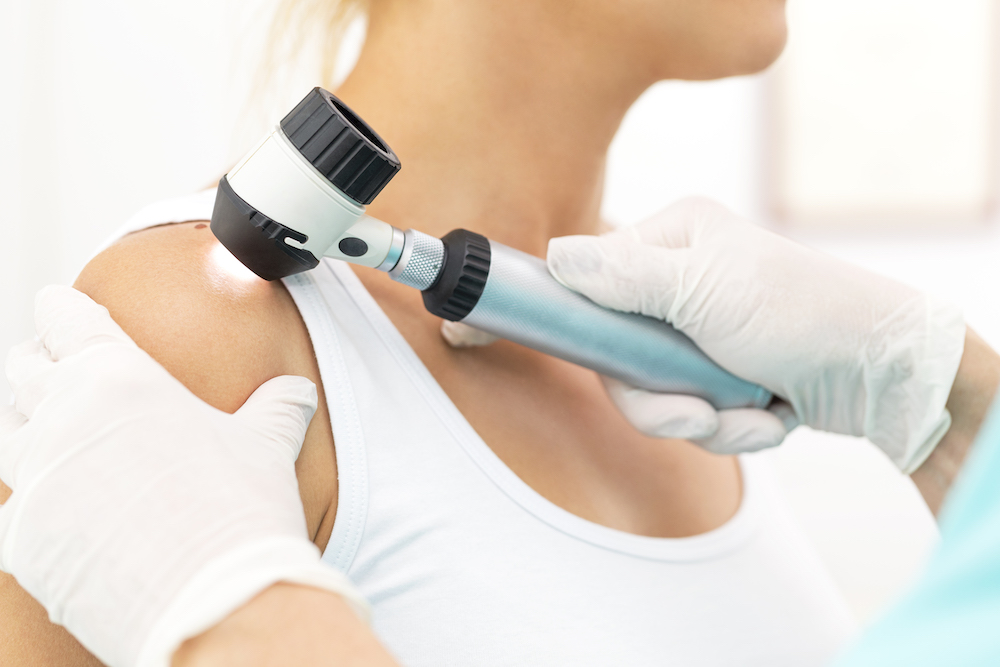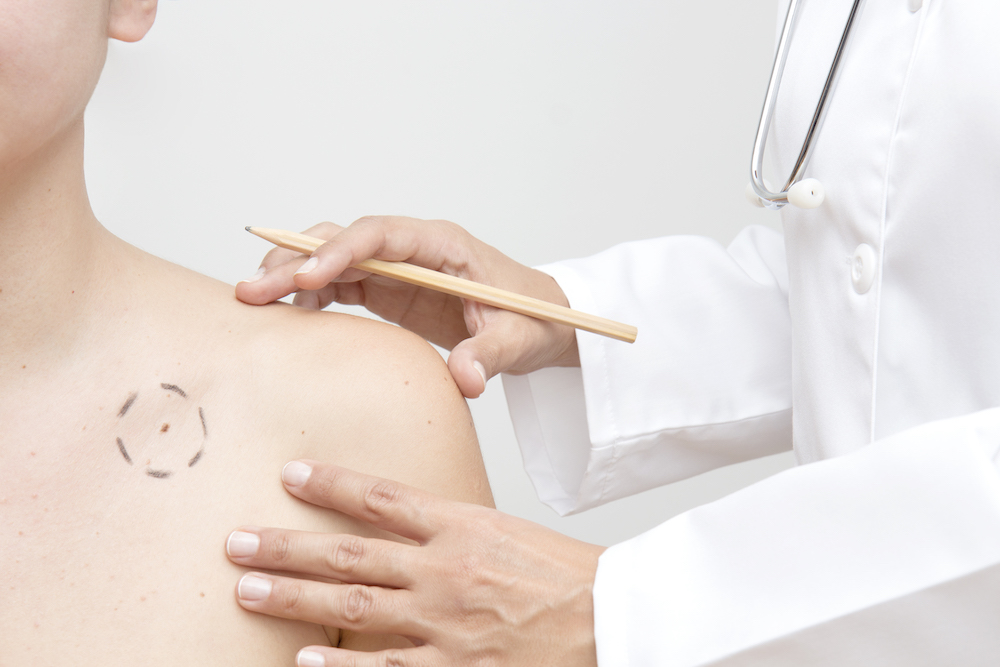ABCDEs of Skin Cancer
The ABCDEs are a memory device for teaching people the things to keep an eye out for when self-checking for possible signs of skin cancer.
- A - Asymmetry
- Benign moles are symmetrical, meaning if you drew a line through the center of the mole the two sides would match. If you draw the line through the center of the mole and the two sides do not match, that is an asymmetrical mole and a warning sign for melanoma.
- B - Border
- Border irregularity is another warning sign for melanoma. A benign mole should have a border that is smooth and even all around, while a malignant mole border would be uneven: scalloped or notched.

- Border irregularity is another warning sign for melanoma. A benign mole should have a border that is smooth and even all around, while a malignant mole border would be uneven: scalloped or notched.
- C - Color
- Check for color variation. Benign moles should all be one color, typically brown, so moles that are a variety of colors are a warning sign. A malignant mole may be several shades of brown, black, tan, or even red, white, or blue.

- Check for color variation. Benign moles should all be one color, typically brown, so moles that are a variety of colors are a warning sign. A malignant mole may be several shades of brown, black, tan, or even red, white, or blue.
- D - Diameter
- Benign moles are usually smaller in diameter than malignant ones. A malignant mole is usually larger in diameter than the eraser at the tip of a pencil, though they may be smaller when first detected.
- E- Evolution
- Any evolution of the size, shape, color, elevation, or any other trait of a mole, or the emergence of new symptoms such as itching, bleeding, or crusting, are signs that it's time to see a doctor. Benign moles should remain consistent over time.
- Or, the Ugly Ducking
- Anything that stands out or just doesn't look right.
Monthly Self-Skin Checks
There is no official recommendation from the American Cancer Society for early detection of skin cancer, but most doctors will recommend checking your own skin once a month, especially if you are at a higher risk of developing skin cancer. People are considered high risk if they:
- have weakened immune systems
- have had skin cancer previously
- have a strong family history of skin cancer (especially melanoma)
- have fair skin, blue or green eyes, or blonde, red, or light brown hair
- have autoimmune diseases such as lupus
- have inherited conditions such as xeroderma pigmentosum (XP) or nevoid basal cell carcinoma syndrome (Gorlin syndrome)
- have had an organ transplant
- are on medications that lower or suppress your immune system, or make your skin more sensitive to sunlight
- spend a lot of time outdoors
- live or vacation regularly in high-altitudes, or tropical/subtropical climates
If you fall into one of those categories, you should ask your doctor how often they recommend self-skin checks.
The first time you do a skin self-check, make sure to take the time to go over your skin slowly, noting any moles, blemishes, freckles, or other marks on your skin so you can keep an eye out for any changes over time. You should consider noting down any areas you’d specifically like to monitor.
To conduct a self-check, you’ll need:
- two mirrors (one full-length and one handheld)
- a blow dryer or a comb
- a chair or something to sit on
Steps to the self-check:
-
Standing in front of the mirror, starting from the top of your head, examine your face: nose, lips, mouth, ears (front and back), eyelids, your neck, under your chin, everywhere exposed to the sun.
-
Using a blow dryer or a comb, thoroughly inspect your scalp section by section, using the hand mirror to view the back of your head if you’re unable to get a friend or family member to assist.
-
Check your chest and belly. Women will need to lift their breasts to check the skin underneath.
-
Look over your upper arms, beginning at the elbows and moving up to cover your shoulders, underarms, and armpits.
-
Examine your lower arms, starting with your fingers (including the space in between your fingers), fingernails, palms, backs of your hands, wrists, and all up both sides of your forearms.
-
Turn your back to the full-length mirror and use the hand mirror to examine the back of your neck, shoulders, upper back, and any parts of your upper arms you could not see earlier. Then move to your lower back, buttocks, and back of both legs.
-
Sit down, and check the front of your thighs, genital area, down to your shins, ankles, the tops of your feet, between your toes and under toenails. Lift your feet and examine the soles of your feet and your heels. Use the mirror to view the back of your shins.
If you find anything in your checks that concerns you, especially anything new or recently changed in size, shape, or color, or has developed symptoms such as itching, bleeding, or crusting, contact your doctor immediately to schedule a follow-up appointment. At the appointment your doctor will examine the areas that worry you and determine if you need to have any additional testing done.
Dermatologist Visits
Visiting the dermatologist for a full-body skin examination is an important step in skin cancer prevention. Typically, this occurs once every year for higher-risk individuals, but if you find something concerning during a self-check do not wait for a yearly appointment to bring it up to the doctor. Here is some information on what to expect during this visit and how to prepare for it.
Before Your Visit
- Conduct your own skin examination at home, making sure you check your full body. (Check the above section for steps on doing a full at home self-scan).
- Note down any new or changing moles/skin irregularities so that you can inform your physician.
- Make sure to remove any nail polish, makeup, or concealer, so your doctor can perform a full and thorough examination.

During Your Visit
- For a patient with no history of skin cancer or skin irregularities, the physician’s exam will take approximately ten minutes.
- The more moles and irregularities you ask your doctor to inspect, the longer the exam will be.
- The doctor's examination will be similar to the self-check you do at home, but the doctor will have additional tools to use to examine any areas of concern.
- If any areas are of concern to the doctor, they may remove a layer of skin to examine in the lab to determine if the growth is abnormal.

Visit the Rutgers Health Melanoma and Pigmented Lesion Center and the Cancer Institute's Melanoma and Soft Tissue Oncology Program to schedule an appointment.

